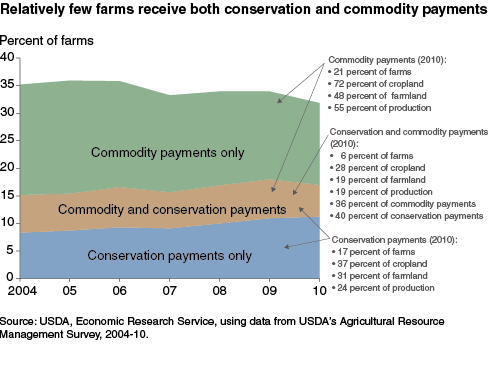Green Payments: Can Conservation and Commodity Programs Be Combined?
- by Roger Claassen
- 3/1/2012
A 'green payments' program, if adopted, would direct support to producers who are good stewards of land, water, and other vital resources. A single program that provides income support to U.S. farmers and leverages improved environmental performance on their farms has intuitive appeal. However, existing conservation and commodity programs have very little in common, and attempting to meld them into a single program raises questions about to whom and under what conditions payments would be extended.
Existing conservation and farm commodity programs serve various purposes, which leads to fundamental differences in how the two types of programs are structured and administered. Commodity-based income programs are intended to support farm families historically involved in the production of targeted crops by enhancing the incomes of eligible producers, primarily the producers of major field crops--corn, wheat, soybeans, cotton, and rice. Conservation payments, on the other hand, are designed to promote change in land use or production practices for a beneficial environmental effect. Conservation payments are available to a wider range of producers; nearly all crop and livestock producers are eligible for at least one conservation program.
In 2010, roughly 32 percent of all farms received commodity payments, conservation payments, or both. These farms were relatively large, accounting for 81 percent of cropland, 60 percent of farmland, and 60 percent of agricultural production. Only 6 percent of farms, however, received both commodity and conservation payments. These farms accounted for much smaller shares of cropland, farmland, and production while receiving roughly 40 percent of commodity and conservation payments. Sixty percent of conservation payments went to farms that did not receive commodity payments, while 64 percent of commodity payments went to farms that did not receive conservation payments. Since 2004, the proportion of farms receiving both conservation and commodity payments has remained fairly constant.
Given the current differences in the recipients of conservation and commodity payments, would a green payments program extend income support to producers who participate in existing conservation programs but are ineligible for existing income support payments? Would the recipients of existing income support face new conservation and environmental requirements or risk losing their payments? Green payment program design would require answers to these and many other questions.
This article is drawn from:
- Claassen, R., Aillery, M. & Nickerson, C. (2007). Integrating Commodity and Conservation Programs: Design Options and Outcomes. U.S. Department of Agriculture, Economic Research Service. ERR-44.
- Claassen, R. & Morehart, M. (2006). Greening Income Support and Supporting Green. U.S. Department of Agriculture, Economic Research Service. EB-1.


